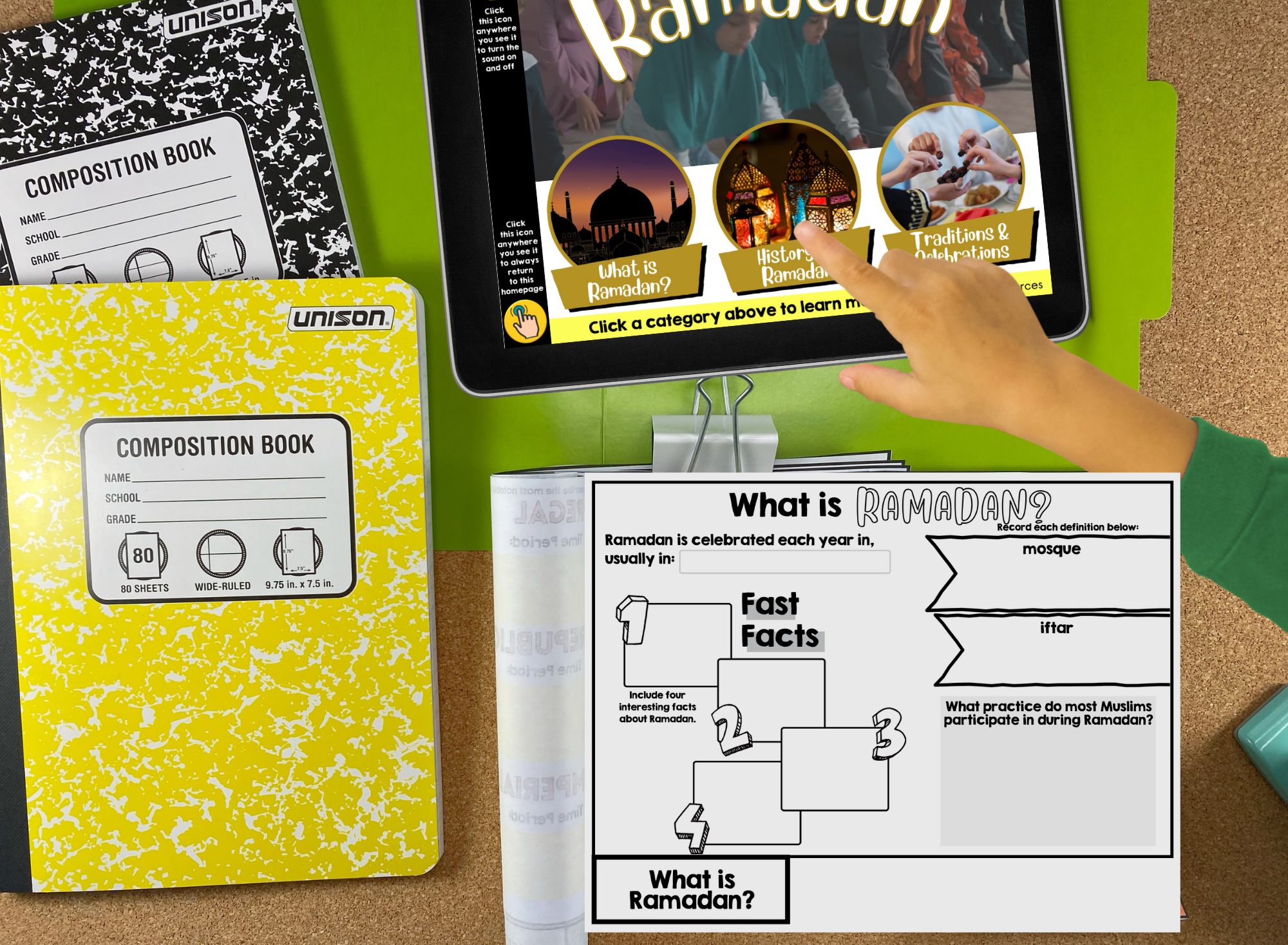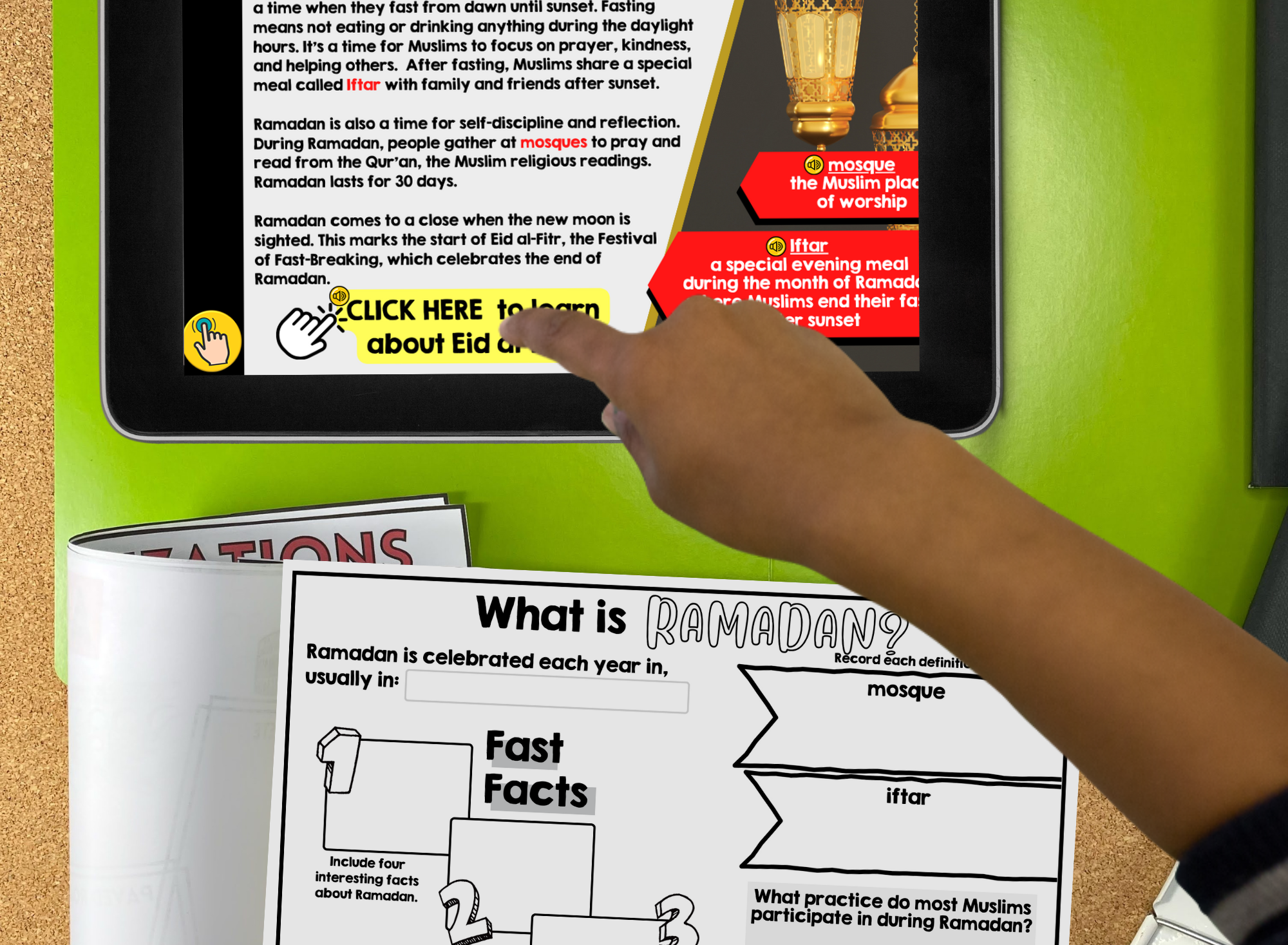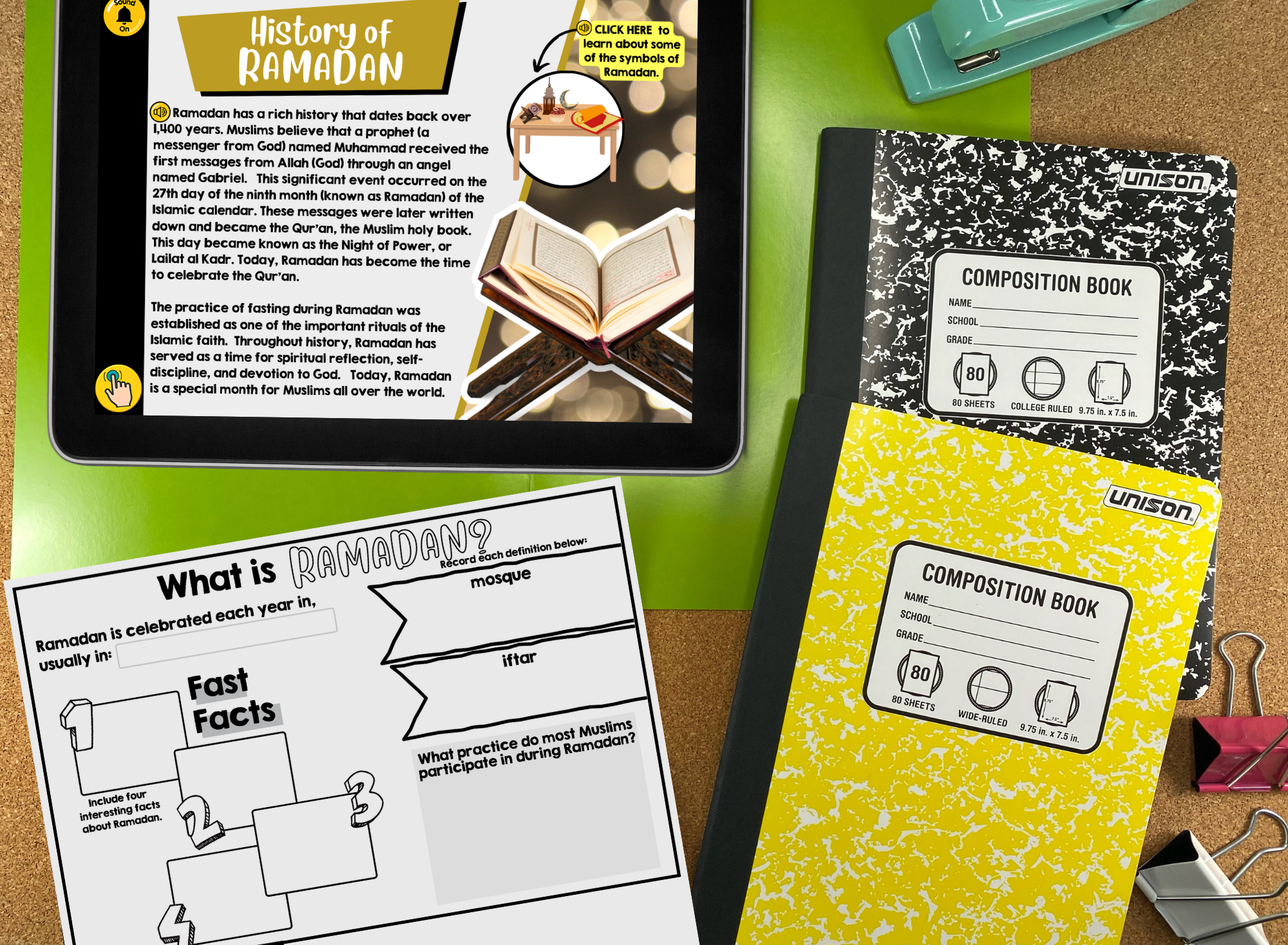Discover Ramadan: Fun and Inclusive Ways to Teach Kids About the Islamic Tradition!
As we strive to create inclusive and culturally rich learning environments, teaching our students about holidays from around the world, like Ramadan, is a wonderful opportunity to celebrate diversity and promote empathy. In this post, I'll share some fun and educational ideas for teaching kids about Ramadan, specifically tailored for upper elementary grades (3rd, 4th, and 5th).
Understanding Ramadan: Explaining the Basics
Let's start with the basics. Ramadan is a sacred month in Islam, during which Muslims fast from dawn until sunset, focusing on spiritual reflection, prayer, and acts of charity. When introducing Ramadan to your students, it's important to provide a clear and age-appropriate explanation.
You may know that I taught in an urban district, which allowed me to work with a hugely diverse group of students. My class was filled with refugees from all over the world, and students from a variety of religions and cultures. Most years, I had at least one Muslim student in my classroom. If he or she felt comfortable, I would invite those students to share what Ramadan meant to them. Not all students were comfortable doing this, but for those that were, it helped make the learning more authentic.
Using multimedia is a great way to make learning fun and engaging! Check out this video that gives an age-appropriate explanation of Ramadan.
The goal of teaching Ramadan to students (even if you don’t have any Muslim students in your classroom) is to promote cultural diversity and empathy. As the teacher, it would also be helpful to expand your understanding a bit beyond the basics and share additional information that might be appropriate for your learners.
History of Ramadan
Ramadan traces its origins back to the 7th century CE when the Quran, the holy book of Islam, was revealed to Prophet Muhammad by the angel Gabriel over a period of 23 years. The revelation began during the month of Ramadan, the ninth month of the Islamic lunar calendar, making it a spiritually charged time for Muslims.
Symbols of Ramadan:
Several symbols are associated with Ramadan, each carrying its own significance and meaning. The most prominent symbol is the crescent moon, which marks the beginning and end of the month. The sighting of the crescent moon signals the start of Ramadan, while its absence marks the conclusion of the month and the celebration of Eid al-Fitr, the festival of breaking the fast. The crescent moon serves as a reminder of the lunar calendar's role in determining Islamic months and the cyclical nature of time.
Another symbol of Ramadan is the lantern, known as the "fanous" in Arabic. Historically used to light the streets and mosques during Ramadan nights, lanterns have become emblematic of the month's festive atmosphere and spiritual illumination. They symbolize the light of knowledge and guidance found in the teachings of Islam, guiding believers on their journey of self-reflection and spiritual growth during Ramadan.
Main Traditions of Ramadan:
The primary tradition of Ramadan is fasting, known as "Sawm" in Arabic. Muslims abstain from food, drink, from dawn until sunset throughout the month. Fasting during Ramadan is obligatory for adult Muslims, with exceptions for those who are ill, pregnant, nursing, or the elderly. Fasting serves as a means of purifying the soul, developing self-discipline, and empathizing with the less fortunate.
Another central tradition of Ramadan is increased devotion to prayer and recitation of the Quran. Muslims engage in additional prayers, known as "Taraweeh," performed nightly during Ramadan in congregation at mosques or at home.
Charitable giving, or "Zakat" in Arabic, is another integral aspect of Ramadan. Muslims are encouraged to give to those in need, whether through monetary donations, food distribution, or volunteering.
Interactive Learning Activities: Engage & Educate
Ramadan Learning Corner
One of the best ways to teach kids about Ramadan is through hands-on activities. Consider setting up a "Ramadan corner" in your classroom, complete with books, crafts, and resources related to the topic. For example, you could organize a Ramadan craft session where students create their own lanterns (check out this video tutorial), or design greeting cards for Muslim classmates observing Ramadan.
Multimedia Learning with LINKtivities
I often love allowing students to explore a topic on their own. LINKtivities make that easy! Our team at LINKtivity® Learning created this kid-friendly LINKtivity® all about Ramadan. It makes it easy to put students in the drivers seat as they explore videos, graphics, text, and more! Multimedia features are the perfect way to capture students’ attention (and keep it!), especially when learning about a new topic.
Through this multimedia EDU-venture, students will learn the meaning and history behind the holiday, as well as some traditions and celebrations in the Muslim community.
Use this LINKtivity as morning work, an easy learning center, or even a whole-class learning experience!
YOU MAY ALSO LIKE: Upgrade Your Teaching - Tips & Tools for Infusing Multimedia Into Your Every Day Instruction (Workshop Series)
Guest Speakers
To truly understand Ramadan, students need to explore its cultural significance. If possible, invite guest speakers from the Muslim community to share their experiences and traditions. One year, I invited a parent to talk about her family's Ramadan traditions, and the students were fascinated to learn about different customs and practices. You could also incorporate music and art from Muslim-majority countries to create a sensory-rich learning experience.
Literature Integration: Stories that Inspire Understanding
Children's books are a fantastic way to introduce students to the concepts of empathy and diversity. Choose age-appropriate books that feature characters celebrating Ramadan, such as "Lailah's Lunchbox" or "Golden Domes and Silver Lanterns." After reading the books together, facilitate discussions about the themes of kindness and inclusivity found within the stories. Keep these books available for students to read on their own as well.
Here’s a list of books that would work great for teaching Ramadan: (affiliate links included)
Cross-Curricular Connections
Don't limit your Ramadan lessons to one subject! Look for opportunities to integrate them into various areas of the curriculum.
For example, in social studies, explore the geography of Muslim-majority countries and the cultural significance of Ramadan in different regions.
Even if you can't physically visit Muslim-majority countries during Ramadan, you can still take your students on virtual field trips to explore different cultures and traditions. Use technology like Google Earth to connect with classrooms around the world and learn about how Ramadan is celebrated in different countries. You could also virtually tour historical landmarks and mosques, providing students with a deeper understanding of Islamic heritage.
Here are a few Islamic landmarks around the world that you can explore through Google Earth:
Imam Square in Esfahan, Iran
Aga Khan Park in Toronto, Canada
Hassan II Mosque in Casablanca, Morocco
The Taj Mahal in Agra, India
The Cave of Hira in Mecca, Saudi Arabia
I’ve even create a Google Earth tour of these places that you can easily navigate through with your students. CLICK HERE to view!
YOU MAY ALSO LIKE: 12 Ways to Use Google Earth with Elementary Students
In math, students can practice calculating the duration of fasting hours based on sunrise and sunset times.
In science, explore the phases of the moon. This video from SciShow Kids provides a great explanation that would be quick to watch, even if you’re not studying the solar system at this time.
Reflection and Discussion: Encouraging Critical Thinking
Finally, provide opportunities for students to reflect on their learning and engage in meaningful discussions about Ramadan. By incorporating fun and interactive activities into your lessons, you can create a learning experience that celebrates diversity and promotes empathy. Remember, the goal is not just to teach about Ramadan but to inspire understanding and appreciation for different cultures and traditions.





